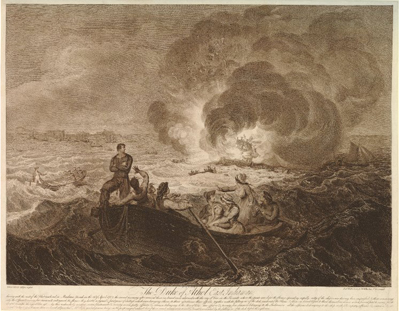Welcome to James Gillray: Caricaturist

© Trustees of the British Museum
At the Crossroads*
Though Gillray might have found creating satiric prints preferable to engraving buttons and calling cards, the profession of caricaturist was the lowest of the low in the artistic world of the 1770s and 80s. History painting, portrait painting, even landscape and animal painting were deemed more worthy endeavors and compensated accordingly. So in the Spring of 1778, the 21 year old Gillray enrolled in the recently founded Royal Academy schools with the hope no doubt of becoming a "legitimate" artist. An undated trade card in the British Museum suggests that, like many aspiring artists, he set his sights on portrait painting as his goal.
At the Royal Academy, he would have been able to take classes in anatomy, drawing, painting, and engraving from well known artists such as Benjamin West, Giovanni Cipriani, and Philip James de Loutherbourg, and engravers such as Francesco Bartolozzi. And, of course, he would also have been able to hear the annual Discourse from the Academy's esteemed president, Sir Joshua Reynolds. We don't know for sure how long he stayed at the school or with whom he might have worked. But he clearly benefited from the experience. The Liberty of the Subject [1779] already shows a marked improvement over Grace Before Meat, or a Peep at Lord Peter's [1778] in the fullness and variety in the characterization of the figures, their arrangement across the picture space, and in the increased sense of perspective.

© Trustees of the British Museum
Another result of his time at the Royal Academy was an improvement in his etching and engraving skills. Although the sale of caricature prints was increasing, the most popular items in 18th century print shops were engravings of portraits and history paintings. And a very good living could be made by the artist who was skilled in stipple engraving, the crayon manner, and other techniques for representing the softness and shading of painting. First in 1780 with two illustrations to Fielding's Tom Jones and especially in 1784 and 1785 when he virtually abandoned caricature, Gillray tried his hand at this too. Prints like The Duke of Athol East Indiaman demonstrate that Gillray had studied Bartolozzi well and had mastered the variety of techniques for producing a high quality painting-like print. But thankfully for 18th century caricature, Gillray's repeated efforts to establish himself as a "serious" artist and engraver never really took hold. After 1785, with a few exceptions, Gillray's unflagging commitment as an artist expressed itself in the inventiveness, sophistication, and astonishing quality of his graphic satire.
* All of the information in this brief overview of Gillray's life is derived from Draper Hill's wonderful biography, Mr. Gillray The Caricaturist, and M. Dorothy George's Catalogue of Prints and Drawings in the British Museum: Political and Personal Satires, the essential foundation of any discussion of caricature in the 18th century.